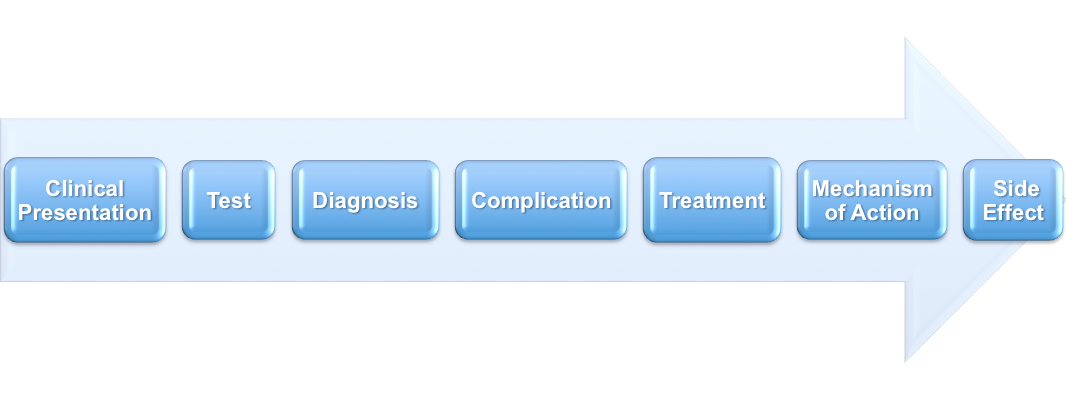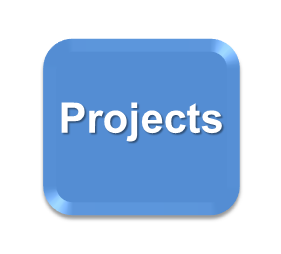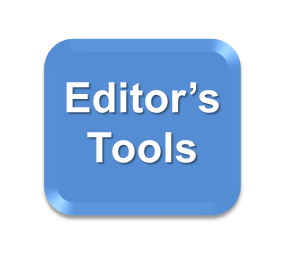How to create a board review question
| WikiDoc Board Review |
|---|
| The Project |
| The Team |
| Guidelines |
| Question List |
| Quality Checklist |
| Medical Illustrations |
| Question Template |
| High Yield! |
| Normal Labs |
| Mnemonics |
| Test Taking Tips |
| Resources |
Editor-In-Chief: C. Michael Gibson, M.S., M.D. [1]; Associate Editor(s)-in-Chief: Charmaine Patel, M.D. [2]; Aarti Narayan, M.B.B.S [3]; Raviteja Guddeti, M.B.B.S. [4]; Gonzalo A. Romero, M.D.
How to Build a Question
- Read and understand the tested material to grasp basic principles, diagnostic approach, management and therapeutics according to the BOARD level.
- Get familiar with the format, content and high Yield material. Take many exams using Q-banks, the NBME website [[5]] and the actual exam, when ready!. Respect Copy Rights sources from Q-banks.
- Select a specific content
- Use WikiDoc to obtain information, pictures, videos, and links on the explanations.
- hallenge the test taker: do not give away the correct answer. Avoid using proper or specific signs. Describe signs and symptoms in lay terms to give the hints. Example: instead of “marfanoid appearance”, describe the patient with long extremities, skinny appearance and tall.
- Do not ask negatively i.e. "which of the following is incorrect, not correct or false?".
- Long stems help recreate the challenge on test date. Short and moderate stems test specific facts.
Multi-step or Jump Question
Include 2 or 3 Jump questions in order to test the medical thinking process, not just the content. Follow these steps:
- Select one box with a specific topic (i.e. clinical presentation) from the diagram shown below. Use facts such as: the clinical presentation (symptoms and signs), the physical exam findings, specific test findings (i.e. labs, imaging, biopsy), the definitive diagnosis, the treatment of choice, its mechanism of action and the most common adverse effect associated with that medication.
- Describe the first box (i.e. typical clinical presentation) in the question stem.
- Ask a specific fact about another box (i.e. what is the mechanism of action of the treatment of choice?). If possible, revert the order and add extra steps.
- You just created jump question!

Example
Microbiology questions require the reader to make the diagnosis, identify the treatment of choice and to know the mechanism of action (3 steps). An equally difficult but less elegant question could ask what HLA-subtype is associated with a rheumatological disease.
Steps to Upload a Question
- Go to the home page on WikiDoc, and click on the icon that says, "Board Review", or click here.
- Click on the big green icon that says "add a board review question".
- Type in your name in the Author Box.
- Select the Exam Type.
- Categories for the question will appear; check off ONE main category, and the appropriate subcategory.
- Introduce an Overall Explanation into the Box focusing on the correct answer choice.
- Use the remaining boxes to type in the answers to the questions and each answer choice explanation.
- You can add an image, if possible.
- Click save page if you're done, or show preview if you like to see how your question will look like.
- Make sure you click save page before you move on!
- Self quality check your work using the WBR quality checklist
- Contact via email the WBR Editors in Chief and WBR Team Members to review your question
- CONGRATULATIONS! You just created a high quality WBR Question!
Question's Design
Question Stem
- The questions are preferred to be narrated as a clinical vignette, which is not an actual case.
- The information and illustrations should be the testing point
- Below are some of the key points that can be found in a question. They should be orderly included as follows:
- Age, Gender (e.g., a 70 year-old man)
- Site of Care (e.g., comes to the emergency department)
- Duration (e.g. that has started one week ago)
- Significant patient history
- Significant family history
- Significant diagnostic studies or the results of diagnostic studies
- Try as much as possible to include images whether still or motion
- Initial treatment and response
- The questions should not include negative phrasing, such as “except” or “not”
Answer Choices
- Answers should include five choices, with one correct answer and the remaining answers are distractors.
- Answers should not be "true" or "false".
- All distractors should be homogeneous, as they should fall in the same category as the correct answer and should be similar in length.
- Long correct answers are discouraged.
- Illogical answers, absolute terms, word repeats (for example: a word or phrase in the correct answer choice, is the same as in the stem) are discouraged.
- “None of the above”, “All of the above” or some combination of response must not be used.
Answer Explanations
- These questions are intended to teach using sources such as: graphics, references and guidelines if applicable.
Overall Explanation
- Only ONE answer is the best or the most appropriate one
- Justify why that choice is correct: explain the pertinent positive findings, not just list the tested subject. (i.e. the patient has this symptom which is a typical presentation of this disease). Explain also the pertinent negatives.
Individual Answer Choice Explanation
- Include why the correct answer is correct and why each of the distractors are incorrect.
- Include concise, yet thorough explanation providing a high yield information.
- Add additional information to the correct answer explanation, not explained on the overall explanation.
Educational Objectives
- Include short high yield facts (1 or 2 take-home sentences/phrases).
References
References should be included, if possible, linking to new articles, review articles or guidelines that serve the initial teaching goal of the questions.
Resources
Internal Resources
- Use WikiDoc content
- Promote WikiDoc use inserting internal links into the explanations
External Resources
Mention external sources used respecting Copy Rights.
- Books:
- First Aid for STEP 1 2014 (latest edition), by Tao Le and Vikas-Bhushan, updated yearly by students who aced the exam and by faculty physicians
- First Aid for Step 2 CK, eight edition, by Tao Le and Vikas-Bhushan. updated biyearly
- Med-Essentials For Step 1: High Yield Review, the fourth edition, by Kaplan Medical
- Master the Boards for Step 2 CK, the second edition, by Dr. Conrad Fischer
- Master the Boards for Step 3, the second edition, by Dr. Conrad Fischer
- Forums:
- www.usmle-forums.com, recent test takers give feedback about their experience and commonly tested facts, updated constantly
Matching Sets
The format remains the same as above, but it tests two or three different concepts on separate questions having the same clinical vignette.
USMLE Step 1 Question Format
- Test the basic principles using calculations, clinical scenarios, and multimedia.
Case Scenarios
- Age
- Gender
- Past history and medications if remarkable
- Chief complaints and assoicated symptoms
- Vital signs and pertinent physical findings
- Laboratory results
- Heart or lung auscultation audios
- Electrocardiography if relevant
- Pathologic or radiographic images
Commonly Asked Questions
- A deficiency of which of the following enzyme activities is the most likely cause of the findings in this patient?
- A mutation in which of the following genes is the most likely cause of the findings in this patient?
- A mutation is most likely to be found in which of the following genes?
- Inheritance of mutant alleles most likely caused impairment of which of the following enzyme activities in this patient?
- Pathologic examination is most likely to disclose an abnormality involving which of the following?
- Synthesis of which of the following substances is most likely to be inhibited as a result of this therapy?
- The causal organism is most likely transmitted by which of the following routes?
- The most appropriate next step in management is administration of which of the following?
- The most likely cause of these findings is a deficiency of which of the following nutrients?
- The morphologic changes most likely indicate which of the following processes?
- This patient most likely has which of the following conditions?
- This patient is at increased risk for developing which of the following as a result of this therapy?
- This patient is most likely receiving treatment with which of the following drugs?
- This patient is most likely to develop which of the following adverse effects?
- This patient is most likely to have a deficit of which of the following?
- This patient most likely had a recent history of which of the following?
- This patient should be monitored for which of the following adverse effects?
- To prevent further damage, which of the following is the most appropriate recommendation?
- Which of the following abnormalities is the most likely cause of these findings?
- Which of the following best explains these findings?
- Which of the following defense mechanisms best explains this patient’s behavior?
- Which of the following best explains this behavior?
- Which of the following findings is most likely?
- Which of the following graphs shown best corresponds to these results?
- Which of the following is the most likely causal organism?
- Which of the following is the most likely cause of death in this patient?
- Which of the following is the most likely cause of this patient's condition?
- Which of the following is the most likely cause of this patient's current condition?
- Which of the following is the most likely diagnosis?
- Which of the following is the most likely mechanism of action causing these adverse effects?
- Which of the following is the most appropriate initial treatment for this patient?
- Which of the following is the most appropriate next step in management?
- Which of the following is the most appropriate pharmacotherapy?
- Which of the following is the most appropriate response by the physician?
- Which of the following labeled areas is most likely damaged?
- Which of the following mechanisms best explains this cytogenetic abnormality?
- Which of the following pathologic findings is most likely seen in a biopsy specimen in this patient?
- Which of the following processes best describes these findings?
- Which of the following processes is most likely to occur in this patient as a result of the disease?
- Which of the following sets of changes most likely occurred following the infusion of drug X?
- Which of the following sets of laboratory findings is most likely in this patient?
- Which of the following sets of physiologic changes is most likely following administration of the drug?
- Which of the following treatments is most appropriate at this time?
USMLE Step 2 CK Question Format
- Follow the most recent Algorithms/Guidelines from WikiDoc
- Useful resources are the books: Master the Boards and First Aid for Step 2 CK
- Include basic STEP 1 questions; 50-60% of the knowledge from Step 2CK comes from Step 1
- Include labs
- Make long stems
- Accommodate information within the vignette that will benefit the test taker to identify the proper answer choice
- Include extra information that is not necessary leading towards the correct answer (distractors)
- Audio and video questions would be ideal also
Case Scenarios
- Age of patient
- Sex
- Past history if remarkable
- Chief complaint
- Vitals
- Describe the chief complaint
- Physical examination findings
- Laboratory findings
- Image or video (if applicable)
Commonly Asked Questions
- What is the most likely diagnosis?
- What is the most likely cause for this condition?
- What is the next best step in management?
- What is the best initial treatment?
- What is the best treatment for this condition?
- What is the best/ most accurate laboratory test to confirm diagnosis?
- What is the drug of choice to treat this condition?
- What is the most likely physical exam finding? (eg. On auscultation, abdominal examination, etc.)
- Which of the following is the most likely underlying mechanism?
- What is the most common risk factor for this condition?
- What is the most common complication of this condition?
- What is the best drug/ drug of choice used to treat this condition?
USMLE Step 3 Question Format
Testing mainly on management of case, covering the following fields:
Application of Concepts
- What is the most likely cause for this condition?
- What is the most likely underlying mechanism?
- What is the cause of (sign/ physical exam finding)?
- Questions related to research studies
History and Physical Examination
- What is the most likely physical exam finding?
- What facts from the past history are important for diagnosis?
- What is the most common risk factor for this condition?
Laboratory and Diagnostic Studies
- What is the most appropriate/accurate laboratory test to evaluate this patient?
- What is the most appropriate laboratory test to evaluate the efficacy of current treatment?
- What is the best initial laboratory test to order?
- What is the most likely result of this laboratory test seen in this condition?
- What is the most likely laboratory finding seen in this condition?
Diagnosis
- What is the most likely diagnosis?
- Which condition is most commonly associated with ____?
Prognosis
- Which of the following factors influences prognosis (good or bad)?
- Which of the following is the best/ worst prognostic indicator?
- Which of the following laboratory finding indicates best/ worst prognosis?
- After follow-up, which of the following is the most common factor that indicates favorable prognosis?
- What is the most appropriate counseling advice?
- What is the most common complication of this condition?
- What is the most likely outcome of this condition?
Management
- What is the next best step in management of this patient?
- What is the most appropriate screening test?
- What is the most appropriate preventive measure for this condition?
- What is the best initial treatment?
- What is the most accurate treatment?What is the best drug/ drug of choice used to treat this condition?
- What is the most appropriate discharge plan?
- Which drug is contraindicated in the treatment of this condition?
- Which of the following is a contraindication for the use of this drug?
- What is the most likely adverse effect of this drug?
Ethics and Principles
Wikidoc has strict rules and regulations against plagiarism. Those rules must be followed. Participants for the board review questions project will have to follow the highest standards of ethics and conduct when writing a question.
Links
WikiDoc Links
- MCAT
- USMLE Step 1
- USMLE Step 2-CK
- USMLE Step 2 Clinical Skills
- Step 2 CS study guide
- USMLE Step 3
- Copyleft sources
- How to upload USMLE II Images
- COMLEX-USA


